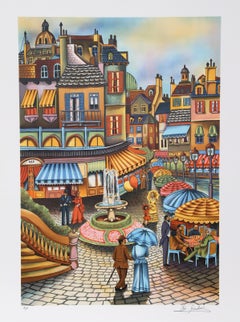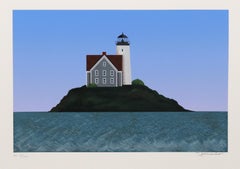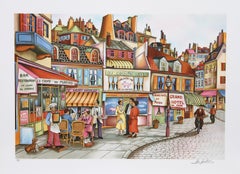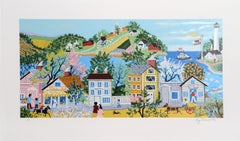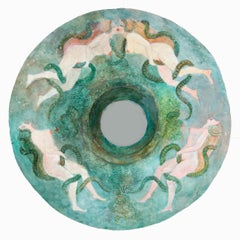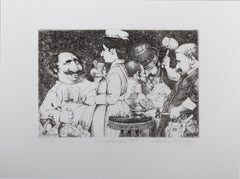Folk Art Art
1980s Folk Art Art
Lithograph
1980s Folk Art Art
Screen
1980s Folk Art Art
Lithograph
1980s Folk Art Art
Screen
1990s Folk Art Art
Plaster, Wood, Acrylic, Mirror
1970s Folk Art Art
Etching
1990s Folk Art Art
Archival Paper, Photographic Paper, C Print, Color, Polaroid
1980s Folk Art Art
Lithograph
1960s Folk Art Art
Marble
1960s Folk Art Art
Marble
2010s Folk Art Art
Metal, Copper
1970s Folk Art Art
Screen
2010s Folk Art Art
Canvas, Oil Crayon, Acrylic
1980s Folk Art Art
Screen
2010s Folk Art Art
Canvas, Oil Crayon, Acrylic
1960s Folk Art Art
Stone, Metal
2010s Folk Art Art
Oil, Canvas
Artist Comments
"There is nothing better than welcoming a new day with the sun shining in a cloudless sky," says artist Pat Forbes. Topsy turvy monochrome structures in pale ...
21st Century and Contemporary Folk Art Art
Acrylic
1960s Folk Art Art
Canvas, Oil
Artist Comments
Using her signature folk art-style, artist Jessica JH Roller captures an endearing portrait of a wolf and two hedgehogs in a verdant abstract landscape. Jessi...
21st Century and Contemporary Folk Art Art
Acrylic
2010s Folk Art Art
Archival Ink, Archival Paper
1970s Folk Art Art
Acrylic
2010s Folk Art Art
Acrylic
20th Century Folk Art Art
Paint, Board
1980s Folk Art Art
Lithograph
Late 20th Century Folk Art Art
Wood, Acrylic
Artist Comments
Symbolic of water's vitality, artist Kira Yustak depicts a sight of hands cupping water from a clear river. She paints the introspective piece with an absorbi...
21st Century and Contemporary Folk Art Art
Acrylic
Artist Comments
Using simplified forms and warm colors, artist Deborah Eyde captures a moment of quiet labor and connection to nature. In this encaustic piece, she depicts a ...
21st Century and Contemporary Folk Art Art
Encaustic
20th Century Folk Art Art
Gouache
Late 20th Century Folk Art Art
Canvas, Oil, Panel
Artist Comments
A colorful scene of a carnival in Rochester, Minnesota, with two young people strapped into their seats waiting for the ride to start. "I love the tawdry splendor of gaudy carnival attractions," says artist Leroy Burt. "Flashing lights and bright colors. One often sees the most unlikely combinations of people who might never meet except during those moments when they sit next to each other on rides."
About the Artist
Artist Leroy Burt paints playful, offbeat landscapes and portraits based on his experiences living in Milwaukee, New York, Costa Rica, and currently Rochester, Minnesota. "I think of my paintings as short stories," he says. As a young child, Leroy faced a number of obstacles. His parents divorced when he was four years old and he was raised by his grandparents in a three-room shack without running water or electricity. Leroy worked hard to pull himself out of poverty. He studied graphic design and painting, which led to a 30-year career in graphic design - five years at WMVS, the PBS television station in Milwaukee, fifteen years at city hall in Milwaukee, and ten years at WNET, the PBS station in New York. In 2015, Leroy retired to focus his energy on painting. Today, he works from a tiny studio filled with half-finished paintings stacked against every wall. "There are photos and sketches for future paintings taped everywhere," says Leroy. "My windows are filled with orchids. There are books, films and music CDs in every corner. And the room is dominated by a black and silver Andy Warhol silkscreen print of Marilyn Monroe."
Words that describe this painting: David Hockney, Edward Hopper, carnival, lights, excitement, colorful, folk art, people, representational, primitive, acrylic painting, blue
21st Century and Contemporary Folk Art Art
Acrylic
Early 2000s Folk Art Art
Archival Paper, Photographic Paper, C Print, Color, Polaroid
Mid-20th Century Folk Art Art
Screen
2010s Folk Art Art
Acrylic
1980s Folk Art Art
Lithograph
21st Century and Contemporary Folk Art Art
Fabric, Canvas, Oil
21st Century and Contemporary Folk Art Art
Oil, Board
2010s Folk Art Art
Blown Glass
2010s Folk Art Art
Ceramic
1980s Folk Art Art
Ink
1980s Folk Art Art
Lithograph
20th Century Folk Art Art
Color Pencil, Mixed Media
Artist Comments
Artist Kira Yustak reveals a charming landscape in her recognizable style of primitivism. A prismatic rainbow emerges from the raging waterfall connecting to ...
21st Century and Contemporary Folk Art Art
Acrylic
2010s Folk Art Art
Oil
2010s Folk Art Art
Acrylic
1970s Folk Art Art
Lithograph
Artist Comments
A colorful scene of a busy street in San Jose, Costa Rica on a hot January morning. "One of the fascinating things about San Jose is the contrasts between the old and the new," says artist Leroy Burt...
21st Century and Contemporary Folk Art Art
Acrylic
Artist Comments
"Just off Brady Street, in Milwaukee’s East Side, there used to be a place with class and style," says artist Leroy Burt. The store was a treasure trove of vintage goodies that were as fun to dig through as to wear. The shop was full of clothing, shoes, jewelry, and bags, some dating back to the golden days of the 40s, 50s, and 60s. The ceiling was pink and covered with toys, trinkets, signs, and other captivating eye candy.
About the Artist
Artist Leroy Burt paints playful, offbeat landscapes and portraits based on his experiences living in Milwaukee, New York, Costa Rica, and currently Rochester, Minnesota. "I think of my paintings as short stories," he says. As a young child, Leroy faced a number of obstacles. His parents divorced when he was four years old and he was raised by his grandparents in a three-room shack without running water or electricity. Leroy worked hard to pull himself out of poverty. He studied graphic design and painting, which led to a 30-year career in graphic design - five years at WMVS, the PBS television station in Milwaukee, fifteen years at city hall in Milwaukee, and ten years at WNET, the PBS station in New York. In 2015, Leroy retired to focus his energy on painting. Today, he works from a tiny studio filled with half-finished paintings stacked against every wall. "There are photos and sketches for future paintings taped everywhere," says Leroy. "My windows are filled with orchids. There are books, films and music CDs in every corner. And the room is dominated by a black and silver Andy Warhol silkscreen...
21st Century and Contemporary Folk Art Art
Acrylic
1960s Folk Art Art
Canvas, Oil
20th Century Folk Art Art
Canvas, Oil
20th Century Folk Art Art
Canvas, Oil
20th Century Folk Art Art
Canvas, Oil
1970s Folk Art Art
Lithograph
Artist Comments
Artist Libby Ramage presents an autumnal scene marked by large leaves falling from the sky. "As the sun fades, a young boy becomes the man," says Libby. Showi...
21st Century and Contemporary Folk Art Art
Acrylic
1970s Folk Art Art
Canvas, Oil
1980s Folk Art Art
Screen
1980s Folk Art Art
Screen
Early 2000s Folk Art Art
Metal
2010s Folk Art Art
Canvas, Acrylic
20th Century Folk Art Art
Screen
